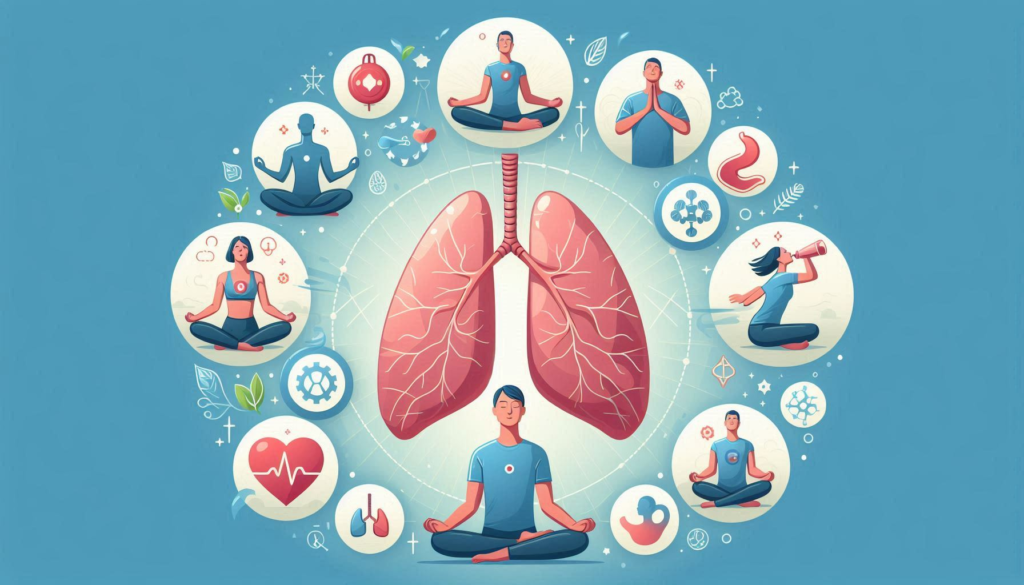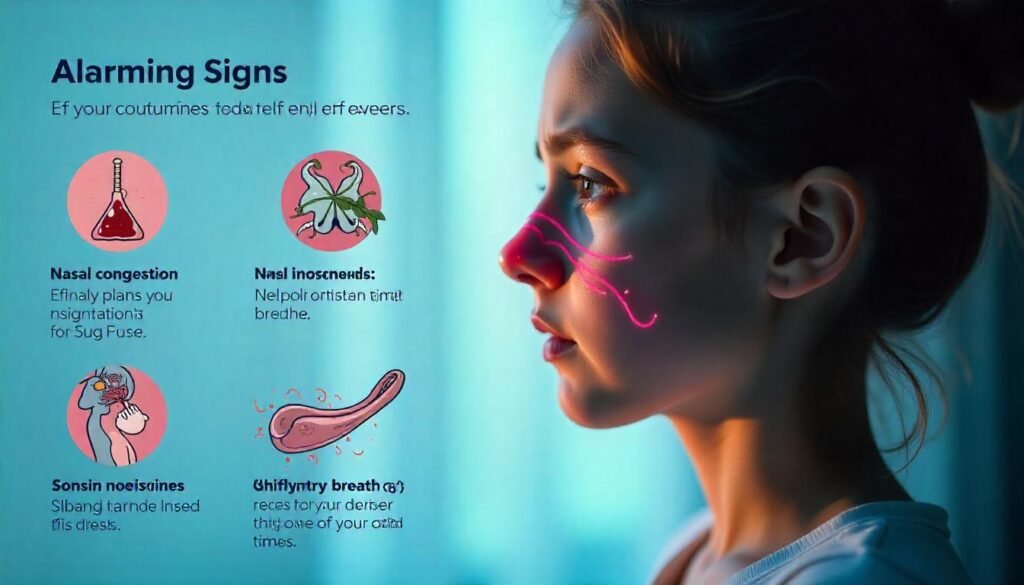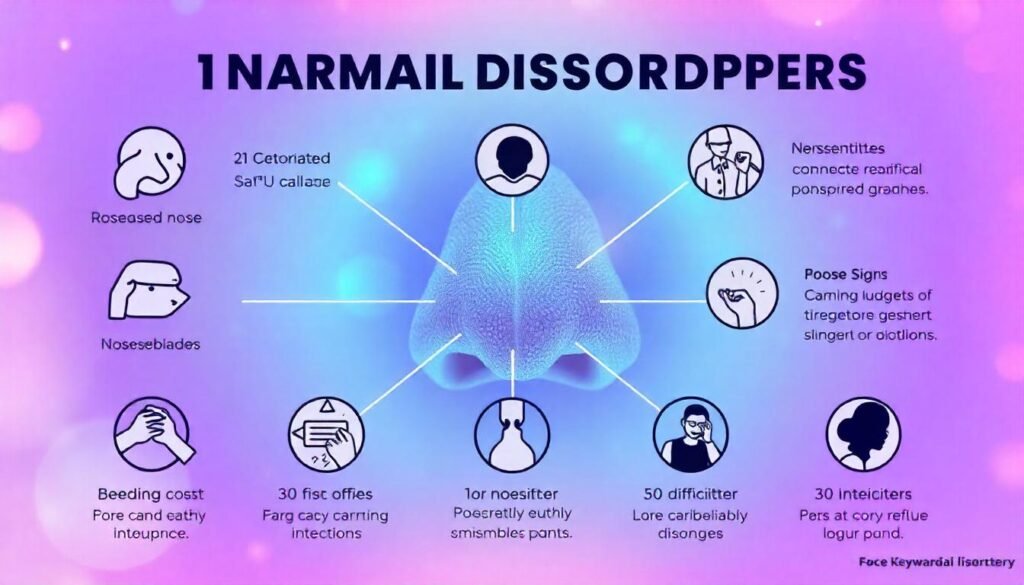
“10 Alarming Signs for Nasal Disorders “
“10 Alarming Signs for Nasal Disorders “
“Alarming signs of nasal disorders you shouldn’t ignore. Learn about symptoms, treatments, and prevention to protect your nasal health.”

Introduction
Brief Overview of the Importance of Nasal Health
Nasal health is crucial for overall well-being and quality of life. The nose plays a vital role in breathing, filtering air, and detecting smells. Maintaining good nasal health helps prevent infections, allergies, and other respiratory issues, ensuring that you can breathe comfortably and enjoy a better quality of life.
Explanation of How Nasal Disorders Can Impact Overall Health and Quality of Life
Nasal disorders can significantly impact overall health and quality of life. Conditions such as chronic congestion, sinus infections, and nasal polyps can lead to difficulty breathing, sleep disturbances, and reduced sense of smell. These issues can cause discomfort, fatigue, and even affect mental health. Early detection and treatment of nasal disorders are essential to prevent complications and maintain optimal health.
Overview of the 10 Alarming Signs to Be Discussed
In this guide, we will explore ten alarming signs of nasal disorders that you should not ignore. These signs include persistent nasal congestion, frequent nosebleeds, chronic sinus infections, loss of smell or taste, nasal pain or pressure, nasal discharge, snoring or sleep apnea, nasal deformities, persistent itching or irritation, and difficulty breathing through the nose. Understanding these signs can help you seek timely medical attention and take preventive measures to protect your nasal health.
Sign 1: Persistent Nasal Congestion
Description of Persistent Nasal Congestion
Persistent nasal congestion refers to a continuous feeling of stuffiness or blockage in the nasal passages. This condition can make it difficult to breathe through the nose and may be accompanied by other symptoms such as a runny nose, sneezing, and postnasal drip.
Possible Causes
- Allergies: Allergic reactions to pollen, dust mites, pet dander, and other allergens can cause chronic nasal congestion.
- Sinusitis: Inflammation of the sinuses, often due to infections, can lead to persistent congestion.
- Nasal Polyps: Noncancerous growths in the nasal passages can obstruct airflow and cause congestion.
- Deviated Septum: A structural abnormality in the nasal septum can block one or both nostrils, leading to chronic congestion.
When to Seek Medical Attention
Seek medical attention if you experience persistent nasal congestion that lasts for more than a few weeks, especially if it is accompanied by other symptoms such as facial pain, fever, or a reduced sense of smell. A healthcare professional can diagnose the underlying cause and recommend appropriate treatment.
Sign 2: Frequent Nosebleeds
Explanation of Frequent Nosebleeds
Frequent nosebleeds, also known as epistaxis, occur when the blood vessels in the nasal passages rupture and bleed. While occasional nosebleeds are common and usually harmless, frequent or severe nosebleeds may indicate an underlying health issue.
Common Causes
- Dry Air: Dry indoor air can dry out the nasal membranes, making them more prone to bleeding.
- Trauma: Nose picking, blowing the nose too hard, or injury to the nose can cause nosebleeds.
- Underlying Health Conditions: Conditions such as high blood pressure, blood clotting disorders, and nasal tumors can lead to frequent nosebleeds.
Treatment Options and Preventive Measures
- Moisturize the Nasal Passages: Use a humidifier to add moisture to the air and apply saline nasal sprays to keep the nasal passages moist.
- Avoid Trauma: Avoid picking your nose and blowing it too hard. Use gentle techniques to clear nasal congestion.
- Seek Medical Attention: If you experience frequent or severe nosebleeds, consult a healthcare professional to determine the underlying cause and receive appropriate treatment.
Sign 3: Chronic Sinus Infections
Overview of Chronic Sinus Infections
Chronic sinus infections, also known as chronic sinusitis, occur when the sinuses become inflamed and swollen for an extended period, typically lasting more than 12 weeks. This condition can cause persistent symptoms and significantly impact quality of life.
Symptoms and Potential Complications
- Symptoms: Symptoms of chronic sinus infections include facial pain or pressure, nasal congestion, thick nasal discharge, reduced sense of smell, and fatigue.
- Complications: If left untreated, chronic sinus infections can lead to complications such as the spread of infection to nearby structures, including the eyes and brain, and the development of nasal polyps.
Treatment Options and When to See a Specialist
- Medications: Treatment options for chronic sinus infections may include antibiotics, nasal corticosteroids, and decongestants to reduce inflammation and clear the infection.
- Surgery: In severe cases, surgery may be necessary to improve sinus drainage and remove obstructions.
- Consult a Specialist: If you experience persistent symptoms of chronic sinus infections, consult an ear, nose, and throat (ENT) specialist for a thorough evaluation and personalized treatment plan.

Sign 4: Loss of Smell or Taste
Description of Anosmia (Loss of Smell) and Ageusia (Loss of Taste)
Anosmia refers to the complete loss of the sense of smell, while ageusia is the complete loss of the sense of taste. These conditions can significantly impact quality of life, as they affect the ability to enjoy food and detect environmental hazards such as smoke or gas leaks.
Possible Causes
- Infections: Viral infections, such as the common cold or COVID-19, can lead to temporary or permanent loss of smell and taste.
- Nasal Polyps: Noncancerous growths in the nasal passages can obstruct airflow and affect the sense of smell.
- Neurological Conditions: Conditions such as Alzheimer’s disease, Parkinson’s disease, and multiple sclerosis can impair the senses of smell and taste.
Diagnostic Tests and Treatment Options
- Diagnostic Tests: Diagnosis may involve a physical examination, nasal endoscopy, imaging tests (such as CT scans or MRIs), and smell and taste tests.
- Treatment Options: Treatment depends on the underlying cause and may include medications (such as corticosteroids for nasal polyps), surgery to remove obstructions, and addressing any neurological conditions. In some cases, smell training exercises may help improve the sense of smell.
Sign 5: Nasal Pain or Pressure
Explanation of Nasal Pain or Pressure
Nasal pain or pressure refers to discomfort or a feeling of heaviness in the nasal passages or sinuses. This symptom can be caused by various conditions and may be accompanied by other symptoms such as congestion, headache, and facial tenderness.
Common Causes
- Sinusitis: Inflammation of the sinuses, often due to infections, can cause pain and pressure in the nasal area.
- Nasal Fractures: Trauma to the nose can result in fractures, leading to pain, swelling, and difficulty breathing.
- Nasal Polyps: Noncancerous growths in the nasal passages can cause discomfort and pressure.
Treatment Options and When to Seek Medical Help
- Treatment Options: Treatment may include medications such as decongestants, pain relievers, and antibiotics for infections. In some cases, surgery may be necessary to address structural issues or remove obstructions.
- When to Seek Medical Help: Seek medical attention if you experience severe or persistent nasal pain or pressure, especially if it is accompanied by other symptoms such as fever, vision changes, or difficulty breathing.
Sign 6: Nasal Discharge
Overview of Different Types of Nasal Discharge
Nasal discharge, also known as a runny nose, can vary in color and consistency. The type of discharge can provide clues about the underlying cause of the condition.
Possible Causes and Associated Symptoms
- Clear Discharge: Often associated with allergies, viral infections, or irritants. It is usually accompanied by sneezing, itching, and watery eyes.
- Yellow or Green Discharge: Typically indicates a bacterial infection, such as sinusitis. It may be accompanied by facial pain, congestion, and fever.
- Bloody Discharge: Can result from trauma, dry air, or underlying health conditions such as nasal tumors or blood clotting disorders.
Treatment Options and When to See a Doctor
- Treatment Options: Treatment depends on the underlying cause and may include antihistamines for allergies, decongestants for congestion, and antibiotics for bacterial infections. Using saline nasal sprays and staying hydrated can also help alleviate symptoms.
- When to See a Doctor: Seek medical attention if you experience persistent or severe nasal discharge, especially if it is accompanied by other symptoms such as facial pain, fever, or vision changes.
Sign 7: Snoring or Sleep Apnea
Description of Snoring and Sleep Apnea
Snoring is a common condition characterized by noisy breathing during sleep. Sleep apnea is a more serious condition in which breathing repeatedly stops and starts during sleep. Both conditions can disrupt sleep and impact overall health.
Impact on Overall Health and Quality of Life
- Snoring: While often harmless, snoring can disrupt sleep for both the affected individual and their partner, leading to daytime fatigue and irritability.
- Sleep Apnea: Sleep apnea can lead to serious health issues such as high blood pressure, heart disease, stroke, and diabetes. It can also cause excessive daytime sleepiness, difficulty concentrating, and mood changes.
Treatment Options and Preventive Measures
- Treatment Options: Treatment for snoring may include lifestyle changes (such as weight loss and avoiding alcohol), positional therapy, and the use of nasal strips or oral appliances. Treatment for sleep apnea may involve continuous positive airway pressure (CPAP) therapy, oral appliances, or surgery to remove obstructions.
- Preventive Measures: Maintaining a healthy weight, avoiding alcohol and sedatives before bedtime, and sleeping on your side can help reduce snoring and improve sleep apnea symptoms.

Sign 8: Nasal Deformities
Explanation of Nasal Deformities
Nasal deformities refer to structural abnormalities in the nose that can affect its appearance and function. Common nasal deformities include:
- Deviated Septum: A condition where the nasal septum (the wall between the nostrils) is displaced to one side, causing obstruction of airflow.
- Nasal Fractures: Breaks or cracks in the bones of the nose, often resulting from trauma or injury.
Symptoms and Potential Complications
- Symptoms: Symptoms of nasal deformities may include difficulty breathing through the nose, nasal congestion, frequent nosebleeds, snoring, and facial pain or pressure.
- Complications: If left untreated, nasal deformities can lead to chronic sinus infections, sleep disturbances, and reduced quality of life due to impaired breathing.
Surgical and Non-Surgical Treatment Options
- Non-Surgical Options: Non-surgical treatments may include the use of nasal strips, decongestants, and nasal sprays to alleviate symptoms.
- Surgical Options: Surgical treatments, such as septoplasty (to correct a deviated septum) and rhinoplasty (to reshape the nose), can address structural issues and improve nasal function. Surgery is typically recommended for severe cases that do not respond to non-surgical treatments.
Sign 9: Persistent Itching or Irritation
Overview of Persistent Nasal Itching or Irritation
Persistent nasal itching or irritation refers to a continuous sensation of itchiness or discomfort in the nasal passages. This symptom can be bothersome and may interfere with daily activities.
Common Causes
- Allergies: Allergic reactions to pollen, dust mites, pet dander, and other allergens can cause persistent nasal itching and irritation.
- Irritants: Exposure to irritants such as smoke, strong odors, and chemicals can lead to nasal discomfort.
- Infections: Viral infections, such as the common cold, can cause temporary nasal itching and irritation.
Treatment Options and Preventive Measures
- Treatment Options: Treatment may include antihistamines for allergies, nasal corticosteroids to reduce inflammation, and saline nasal sprays to keep the nasal passages moist.
- Preventive Measures: Avoiding known allergens and irritants, using air purifiers, and maintaining good nasal hygiene can help prevent persistent nasal itching and irritation.

Sign 10: Difficulty Breathing Through the Nose
Description of Difficulty Breathing Through the Nose
Difficulty breathing through the nose, also known as nasal obstruction, refers to a reduced ability to inhale and exhale through the nasal passages. This condition can significantly impact quality of life and may be accompanied by other symptoms such as snoring and mouth breathing.
Possible Causes
- Nasal Obstruction: Structural issues such as a deviated septum, nasal polyps, and enlarged turbinates can block airflow and cause difficulty breathing.
- Enlarged Turbinates: The turbinates are structures inside the nose that help filter and humidify the air. When they become enlarged, they can obstruct airflow and cause breathing difficulties.
Treatment Options and When to Seek Medical Attention
- Treatment Options: Treatment may include medications such as decongestants, nasal corticosteroids, and antihistamines to reduce inflammation and improve airflow. In severe cases, surgical procedures such as septoplasty, turbinate reduction, and polypectomy may be necessary to remove obstructions and improve breathing.
- When to Seek Medical Attention: Seek medical attention if you experience persistent difficulty breathing through the nose, especially if it is accompanied by other symptoms such as snoring, sleep disturbances, or recurrent sinus infections. A healthcare professional can diagnose the underlying cause and recommend appropriate treatment.
Conclusion
Recap of the 10 Alarming Signs for Nasal Disorders
- Persistent Nasal Congestion: Continuous feeling of stuffiness or blockage in the nasal passages.
- Frequent Nosebleeds: Recurrent bleeding from the nasal passages.
- Chronic Sinus Infections: Long-lasting inflammation and swelling of the sinuses.
- Loss of Smell or Taste: Complete loss of the sense of smell (anosmia) or taste (ageusia).
- Nasal Pain or Pressure: Discomfort or heaviness in the nasal passages or sinuses.
- Nasal Discharge: Runny nose with varying types of discharge.
- Snoring or Sleep Apnea: Noisy breathing during sleep or repeated interruptions in breathing.
- Nasal Deformities: Structural abnormalities in the nose affecting appearance and function.
- Persistent Itching or Irritation: Continuous sensation of itchiness or discomfort in the nasal passages.
- Difficulty Breathing Through the Nose: Reduced ability to inhale and exhale through the nasal passages.
Encouragement to Seek Medical Attention if Experiencing Any of These Signs
If you experience any of these alarming signs, it is important to seek medical attention to determine the underlying cause and receive appropriate treatment. Early detection and intervention can help prevent complications and improve your quality of life.
Final Thoughts on the Importance of Nasal Health and Regular Check-Ups
Maintaining good nasal health is essential for overall well-being. Regular check-ups with a healthcare professional can help detect and address nasal disorders early, ensuring that you can breathe comfortably and enjoy a better quality of life. Prioritize your nasal health by staying informed, seeking timely medical attention, and following preventive measures to protect your nasal passages.
FAQs
Q1: What are the common causes of persistent nasal congestion?
A1: Persistent nasal congestion can be caused by allergies, sinusitis, nasal polyps, or structural issues like a deviated septum.
Q2: How can I prevent frequent nosebleeds?
A2: To prevent frequent nosebleeds, keep your nasal passages moist with saline sprays, use a humidifier, and avoid picking your nose or blowing it too hard.
Q3: What are the symptoms of chronic sinus infections?
A3: Symptoms of chronic sinus infections include facial pain or pressure, nasal congestion, thick nasal discharge, reduced sense of smell, and fatigue.
Q4: How is loss of smell or taste diagnosed?
A4: Loss of smell or taste can be diagnosed through a physical examination, nasal endoscopy, imaging tests, and sometimes neurological evaluations.
Q5: What treatments are available for nasal pain or pressure?
A5: Treatments for nasal pain or pressure may include medications like decongestants and pain relievers, saline rinses, and in some cases, surgery.
Q6: When should I see a doctor for nasal discharge?
A6: You should see a doctor if you have persistent or severe nasal discharge, especially if it is accompanied by other symptoms like fever, facial pain, or vision changes.
Q7: How is sleep apnea related to nasal disorders?
A7: Sleep apnea can be related to nasal disorders if there is an obstruction in the nasal passages that affects breathing during sleep. Treatment may involve addressing the nasal obstruction.
Q8: What are the treatment options for nasal deformities?
A8: Treatment options for nasal deformities include surgical procedures like septoplasty or rhinoplasty, as well as non-surgical options like nasal splints or breathing strips.
Q9: How can I relieve persistent nasal itching or irritation?
A9: To relieve persistent nasal itching or irritation, avoid known allergens and irritants, use antihistamines, and keep your nasal passages moist with saline sprays.
Q10. What should I do if I have difficulty breathing through my nose?
Difficulty breathing through the nose can be uncomfortable and may stem from various causes, including congestion, allergies, structural issues, or infections. Here are some steps you can take to relieve nasal congestion:
- Use a Saline Spray or Rinse
A saline spray or rinse can help clear out mucus and allergens, providing temporary relief. Neti pots are also effective for a deeper nasal cleanse. - Stay Hydrated
Drinking plenty of water can thin mucus, making it easier to breathe. Warm fluids, like tea or broth, may provide extra comfort. - Inhale Steam
Taking a hot shower or inhaling steam from a bowl of hot water can help clear nasal passages. You can add eucalyptus oil for additional relief. - Try Nasal Decongestants
Over-the-counter decongestant sprays or pills can provide short-term relief. However, these should be used sparingly and only for a few days, as they can cause rebound congestion if overused. - Use a Humidifier
Dry air can worsen nasal congestion. A humidifier adds moisture to the air, which can help soothe and open nasal passages. - Elevate Your Head While Sleeping
If nasal congestion worsens at night, try propping your head up with extra pillows. Gravity can help drain mucus and reduce pressure. - Avoid Allergens
Identify and avoid triggers, such as dust, pet dander, or pollen, if allergies are contributing to your nasal congestion. Air purifiers can help reduce allergens in the air. - Try Antihistamines
If allergies are causing nasal blockage, over-the-counter antihistamines may reduce inflammation and help you breathe easier. - Consult a Doctor
If the problem persists or you experience additional symptoms like facial pain, headache, or fever, consult a doctor. Structural issues, such as a deviated septum or nasal polyps, may require medical intervention or surgery.



One Comment
Pingback: